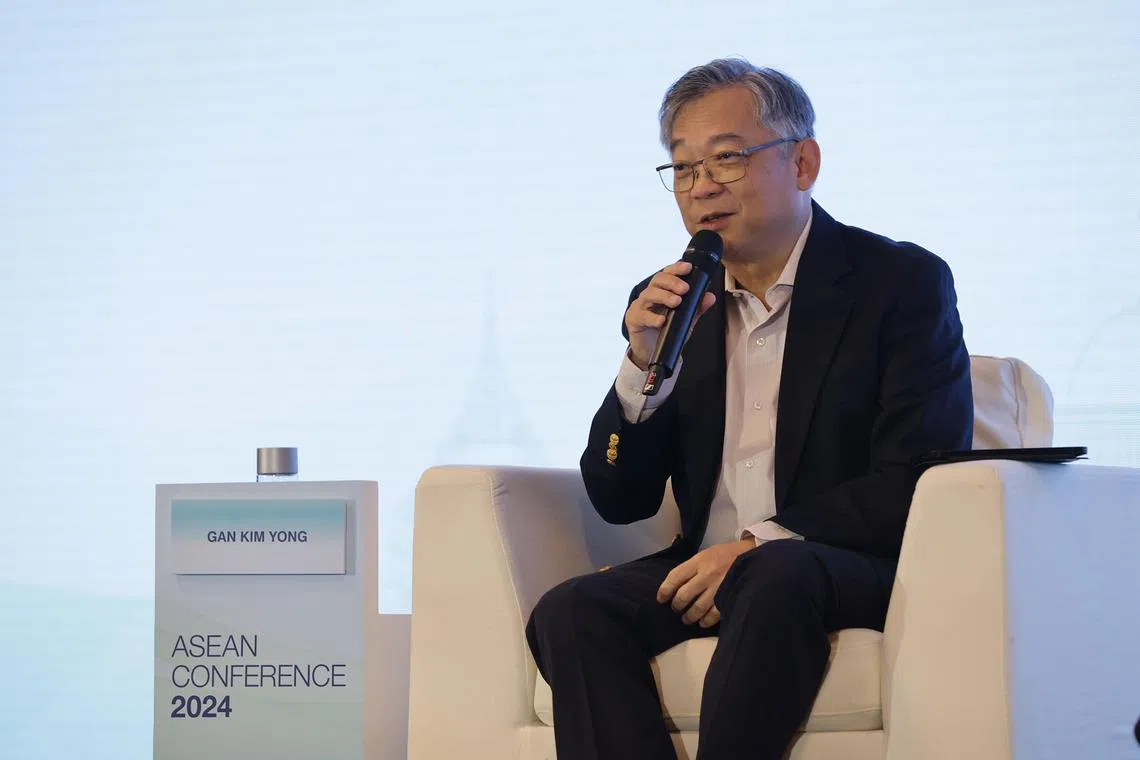Singapore sees Asean as bright spot in a troubled world, says DPM Gan
Sign up now: Get ST's newsletters delivered to your inbox

DPM Gan Kim Yong said Asean countries have the opportunity to show the world how to manage challenges by collaborating with one another.
PHOTO: SINGAPORE BUSINESS FEDERATION
Follow topic:
SINGAPORE – Asean is more relevant for the global economy than ever and its continued growth will bring considerable benefits to Singapore, noted Deputy Prime Minister Gan Kim Yong on Aug 29.
He told the Asean Conference 2024 that the world has become a more difficult place for investors amid US-China trade disputes, wars in Ukraine and the Middle East, tensions in the Taiwan Strait and rising protectionism.
“Amid all of this, Asean is a bright spot. It is increasingly becoming even more important going forward.”
Asean countries have the opportunity to show the world how to manage these challenges by collaborating with one another, added DPM Gan, who is also Trade and Industry Minister.
The nominal gross domestic product of the 10 Asean nations is estimated at around US$3.6 trillion (S$4.7 trillion).
This is expected to hit US$4.5 trillion by 2030, thanks to surging domestic consumption, export-driven manufacturing and a young workforce, making it the world’s fourth-largest economy.
Achieving that milestone means Asean needs to further strengthen its own economic integration, promote sustainability and digitalisation, and broaden trade and investment relations with non-Asean partners, said DPM Gan.
He noted the proposed Johor-Singapore Special Economic Zone (SEZ),
Another project he cited was the Asean Power Grid, under which electricity can be traded first on a cross-border bilateral basis, and then gradually on a total integrated regional power grid system.
“There are many areas where we can come together and explore opportunities,” he said.
“Asean can be a very good example of how to cooperate internally and also strengthen Asean plus-one collaboration with our other trade partners.
“In fact, we can show the way forward to the world on how we come together to protect our interests, and at the same time, create space for collaboration and integration.”
DPM Gan said the fates of Asean countries are tied together in many ways, even though they are at different stages of development: “I have always believed that Singapore will do well only when Asean is doing well.”
Mr Lim Ming Yan, chairman of the Singapore Business Federation (SBF), which organised the event at Sands Expo and Convention Centre, said that while the global outlook remains challenging, South-east Asia has reasons to be cautiously optimistic.
“The region’s growth is supported by strong domestic demand and improvements in both goods and services exports,” he added.
“The diversification of manufacturing and supply chains driven by geopolitical considerations will also support continued strong (foreign direct investment) inflows into the region.”
Mr Lim noted that regional business leaders will review the progress of the Asean Economic Community (AEC) 2025 Blueprint next year.
“While economic integration in Asean will not be at the same level as the European Union, the AEC 2025 is an ambitious road map to create a cohesive, competitive, innovative and dynamic economic community that is integrated with the global economy,” he said.
“We will examine the progress and achievement of the AEC, as well as areas of improvement that Asean could strive towards.”
Some collaborative pacts were also inked on the sidelines of the conference.
SBF signed a memorandum of understanding (MOU) with UOB, law firm Rajah & Tann and tax adviser RSM to drive internationalisation in Asean.
Mr Lim said the agreement will promote activities, including business missions and knowledge sharing, to facilitate business expansion within the region.
“This would help companies to use Singapore as a springboard into the region, and encourage intra-Asean investment flows to spur economic growth for the region,” he added.
UOB also signed two other MOUs. One – with Invest Johor, the Malaysian state’s investment agency – aims to drive business opportunities in the upcoming Johor-Singapore SEZ.
The other deal – with China’s Lingang Group, an industrial park operator with more than 18,000 tenants across China – will involve UOB helping the firm expand into South-east Asia.


